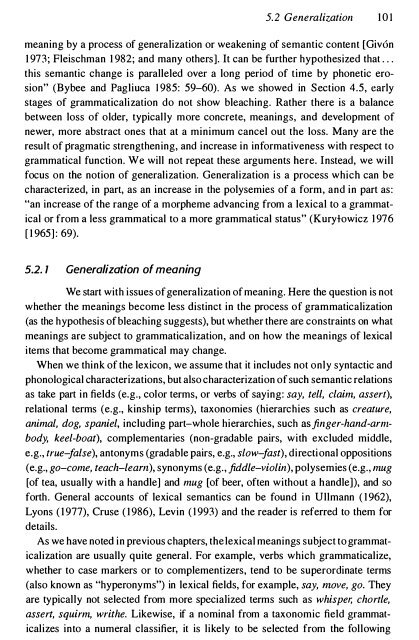Gram - SEAS
Gram - SEAS
Gram - SEAS
Create successful ePaper yourself
Turn your PDF publications into a flip-book with our unique Google optimized e-Paper software.
5. 2 Generalization 10 I<br />
meaning by a process of generalization or weakening of semantic content [Giv6n<br />
1973; Fleischman 1982; and many others]. It can be further hypothesized that . ..<br />
this semantic change is paralleled over a long period of time by phonetic erosion"<br />
(Bybee and Pagliuca 1985: 59-60). As we showed in Section 4.5, early<br />
stages of grammaticalization do not show bleaching. Rather there is a balance<br />
between loss of older, typically more concrete, meanings, and development of<br />
newer, more abstract ones that at a minimum cancel out the loss. Many are the<br />
result of pragmatic strengthening, and increase in informativeness with respect to<br />
grammatical function. We will not repeat these arguments here. Instead, we will<br />
focus on the notion of generalization. Generalization is a process which can be<br />
characterized, in part, as an increase in the polysemies of a form, and in part as:<br />
"an increase of the range of a morpheme advancing from a lexical to a grammatical<br />
or from a less grammatical to a more grammatical status" (Kurytowicz 1976<br />
[1965]: 69).<br />
5.2. 1 Generalization of meaning<br />
We start with issues of generalization of meaning. Here the question is not<br />
whether the meanings become less distinct in the process of grammaticalization<br />
(as the hypothesis of bleaching suggests), but whether there are constraints on what<br />
meanings are subject to grammaticalization, and on how the meanings of lexical<br />
items that become grammatical may change.<br />
When we think of the lexicon, we assume that it includes not only syntactic and<br />
phonological characterizations, but also characterization of such semantic relations<br />
as take part in fields (e.g., color terms, or verbs of saying: say, tell, claim, assert),<br />
relational terms (e.g., kinship terms), taxonomies (hierarchies such as creature,<br />
animal, dog, spaniel, including part-whole hierarchies, such asfinger-hand-armbody,<br />
keel-boat), complementaries (non-gradable pairs, with excluded middle,<br />
e.g., true-false), antonyms (gradable pairs, e.g., slow-fast), directional oppositions<br />
(e.g., go-come, teach-learn), synonyms (e.g., fiddle-violin), polysemies (e.g., mug<br />
[of tea, usually with a handle] and mug [of beer, often without a handleD, and so<br />
forth. General accounts of lexical semantics can be found in Ullmann (1962),<br />
Lyons (1977), Cruse (1986), Levin (1993) and the reader is referred to them for<br />
details.<br />
As we have noted in previous chapters, the lexical meanings subject to gram maticalization<br />
are usually quite general. For example, verbs which grammaticalize,<br />
whether to case markers or to complementizers, tend to be superordinate terms<br />
(also known as "hyperonyms") in lexical fields, for example, say, move, go. They<br />
are typically not selected from more specialized terms such as whisper; chortle,<br />
assert, squirm, writhe. Likewise, if a nominal from a taxonomic field grammaticalizes<br />
into a numeral classifier, it is likely to be selected from the following
















